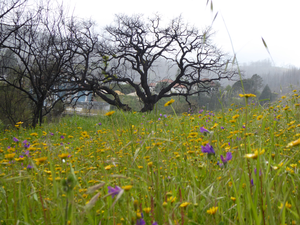Resilience & Re-imagining - 2019

In Situ3 Workshop, 1 - 13 Oct 2019
In one weekend in July 2017, flames engulfed kilometre after kilometre of eucalyptus and pine forests across Spain and Portugal. The wildfires (due to lightning, increasing climate change or suspected pyromania) claimed the lives of 63 individuals in our region. Some were trapped whilst attempting to flee in their cars. Dozens were injured, and thousands evacuated from their homes. Many buildings were destroyed - including our large truck repair hall at Ponte d’ Arte, and with it a substantial amount of our artworks and possessions. (Portugal's biggest wildfire: 'We all thought we were going to die'. The Guardian video, 10 min.)
Have you ever lost something forever? Catastrophe challenges our very ability to make sense of our circumstances and face the future. According to the American philosopher and theorist Judith Butler (2003)[1], following such an incident ”we are marked for life, and that mark is insuperable, irrecoverable. It becomes the condition by which life is risked, by which the question of whether one can move, and with whom, and in what way is framed and incited by the irreversibility of loss itself."
Therefore, at Ponte d’ Arte, we decided to embrace risk, to rebuild, and to keep moving. Will you join us, two years after the fire, on Sunday 13 October, in an art gallery we have constructed out of the ruins? During this 12-day residency you are invited to create in situ artworks as a palimpsest[2], contextualising the event, the region and the resilience of its community. Participate in this recuperating region ‘over-writing’ the traces in the landscape and the numerous remnants of the inferno, whilst contemplating the most effective way to express the disaster and its recovery.
Do you agree with Sigmund Freud[3] that our self (ego) “is composed of the residues of its accumulated losses”? The postmodern feminist psychoanalyst Julia Kristeva [4] describes the difficult thoughts and feelings that persist when events like the fire of 2017 hit us. This melancholic return and re-confrontation with past loss makes possible the slow but eventual work of mourning.
New creative perspectives and exciting prospects are available on the premises and in the immediate neighbourhood. There are abundant residues and relics with palimpsest-like qualities waiting to be explored. The burnt debris and the ensuing rain has yielded astonishing hues, tints and textures, corrosive marks and congealed contorted shapes for you to discover.
Maybe nothing is ever completely lost or gone, if we actively remember it – but memory itself is a re-imagining. “If loss is known only by what remains of it, then the politics and ethics of mourning lie in the interpretation of what remains—how remains are produced and animated, how they are read and sustained” (Eng and Kazanjian 2003, p. ix).
Throughout history, art and society have come together during moments of catastrophe. Such events will continue to offer creative possibilities, so we hope you will join us in creating thought provoking re-interpretations and relationships - palimsests to celebrate resilience.
Preparation
Barca Nostra: The Art of Disaster (artwork at the current Venice Biennale 2019)
“The use of death or catastrophe as a creative object, between sensationalism, morbid attraction and voyeurism, does succeed in highlighting certain ethical debates. But there is a thin line between exploiting a disaster and denouncing it”.
https://www.switchonpaper.com/en/2019/07/12/barca-nostra-the-art-of-disaster/
Please come prepared to tell us what do you think about this.
https://www.theartnewspaper.com/news/christoph-buechel
Sources
[1] Butler in Loss: The Politics of Mourning. Eng, D L and Kazanjian, D. 2003 (eds) Berkeley. University of California Press: p.467.
[2] A palimpsest is a manuscript or writing surface comprising something re-used, overwritten or altered but still bearing visible traces of its earlier form in other words a “multi-layered record.” It can be any kind of "transdoing" and "perspectivation", It may include a translator’s [or artist’s] very personal, subjective attitude or conception (Hans-Harry Drößiger, Athens Journal of Philology - Volume 5, Issue 4: P. 261-284).
See also the work of literary scholar and theorist Gérard Genette (1930-2018) who had a broad impact on the understanding of palimpsest, also known as intertextuality.
[3] Freud in The Ego and the Id (1923), cited in The Politics of Mourning. Eng, D L and Kazanjian, D. 2003 (eds) Berkeley. University of California Press: p.4.
[4] Kristeva cited in The Politics of Mourning. Eng, D L and Kazanjian, D. 2003 (eds) Berkeley. University of California Press: p.4. On the Melancholic Imaginary.